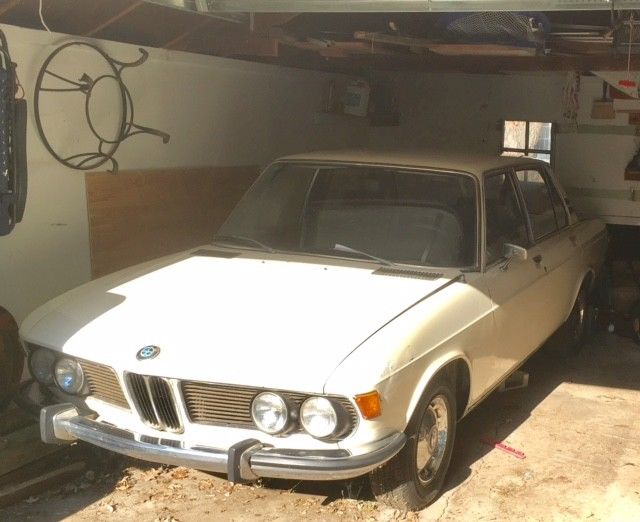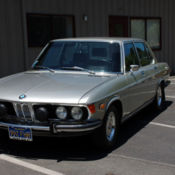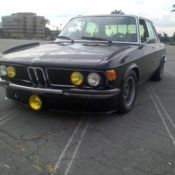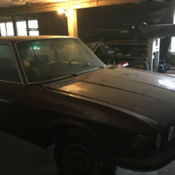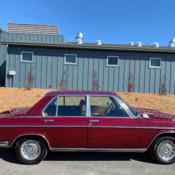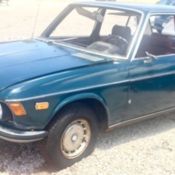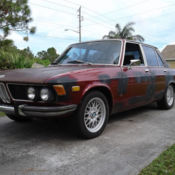1969 BMW 2500 E3 BAVARIA
1969 BMW Other
This is a fairlyrare car, with only about 900 imported into the US that year. It later became the more well known BMW Bavaria. Technologically advanced with independent suspension, 4 wheel disc brakes and 3 point seat belts. These cars are often referred to as E3's or Senior Sixes.1969 2500 w/ 3 speed automaticOdometer reads 73190. I have some service records. The oldest one is from 1980 and the mileage is 54,522, another from 1995 @ 60554 and 2002 @61278. I know the owner before me put a lot of new parts into it and drove it all over northern California. So that may be accurate. I purchased in Berkeley, CA in 2002. I used it as my daily driver for about a year and then had it trucked to OH, where I had moved. I drove it for another 6 months before deciding I needed a more modern vehicle as well as not wanting to drive it in the winter here due to the salt on the roads
Car is pretty much Original as far as I can tell. Body is in good shape. There are a couple small rust spots on drivers side C pillar, and a bit on Wheel well. There is also a small dent on driver side quarter panel. Paint is decent, I think the color is called Chamonix. It has all badges, Wheel covers etc.
Interior is OK for its age. Blue Vinyl. Front seats have some cracking on the seat, especially the drivers side. Rear seats are in good shape previous owner cut holes in door panels (8" round) and rear deck (6"x9') for speakers. Previous owner also added a push button starter.
MechanicalsRadiator has small leakMotor performed well and pulled hard, but was noisy.Transmission has a hard shift from 2nd to 3rd. Gas Tank leaked from seam if overfilled, had to keep it to half a tank or less.I last started it about 4 years ago to move it's position in garage.Title is from California
From HagertyMODEL OVERVIEWHistory of the 1968-1977 BMW BavariaThe 1600 and 2002 were flying out of showrooms by 1968 and BMW set its sights on the upper end of the market. The source of inspiration came once again from von Falkenhausen, who added two more cylinders to the 2002's SOHC four-cylinder engine for a silky smooth, twin carburetor six-cylinder.
The result was two models, the 170 bhp 2500, and the 192 bhp 2800. The engine was canted over 30 degrees to fit under the elegant sedan's low hood, and both engines used a seven-main bearing crank. The two engines were notable for having trispherical turbulence bowl combustion chambers which were so efficient that they eliminated the need for air pumps or exhaust gas recirculators.
The 2500 and 2800 had McPherson struts up front, but angled back for a better ride and improved anti-dive capability. The rear featured the same trailing arm independent suspension as the 2002, again better angled for an improved ride. The sedans were sold in two levels of trim in Europe, with the 2500 as a base model and the 2800 loaded with options, including Boge Nivomat self-leveling suspension. Both models had dual circuit disc brakes all round and a nifty toolkit in the trunk lid.
Importer Max Hoffman decided that price was an important factor (he'd been right with the bare-bones Porsche Speedster in the 1950s) and so the Bavaria sedan was introduced in 1971. It was essentially the 2800 without a lot of its fancy features and a base price of $4,987. Not many people wanted a base car, however, and by the time most were out the door with air-conditioning, power steering, tinted glass and a nice Blaupunkt stero, the prices was over $6,000. The later 3-liter model got fuel injection and power rose to 200 bhp.
BMW had carved a sizeable niche out of the Mercedes-Benz market by 1977, with 222,001 examples of the 2500 and 2800 models delivered, and the model had also spun off the superb 2800CS and 3.0CS coupes, which remain classics. The Bavaria sedan evolved into the 3.0 sedan in 1975 and was replaced by the even bigger 733i in 1977.
Aside from being somewhat finicky mechanically, rust was the Bavaria's biggest enemy and rear shock tower integrity is critical. Significant rust there can be terminal. A side note of some interest is that the "Bavaria" name was never used for the 2500 and 2800 sedans in Europe, but Germans were so proud of it that many US-model Bavaria badges were fitted to cars over there.
">The 1600 and 2002 were flying out of showrooms by 1968 and BMW set its sights on the upper end of the market. The source of inspiration came once again from von Falkenhausen, who added two more cylinders to the 2002's SOHC four-cylinder engine for a silky smooth, twin carburetor six-cylinder.
The result was two models, the 170 bhp 2500, and the 192 bhp 2800. The engine was canted over 30 degrees to fit under the elegant sedan's low hood, and both engines used a seven-main bearing crank. The two engines were notable for having trispherical turbulence bowl combustion chambers which were so efficient that they eliminated the need for air pumps or exhaust gas recirculators.
The 2500 and 2800 had McPherson struts up front, but angled back for a better ride and improved anti-dive capability. The rear featured the same trailing arm independent suspension as the 2002, again better angled for an improved ride. The sedans were sold in two levels of trim in Europe, with the 2500 as a base model and the 2800 loaded with options, including Boge Nivomat self-leveling suspension. Both models had dual circuit disc brakes all round and a nifty toolkit in the trunk lid.
On Sep-23-17 at 08:35:00 PDT, seller added the following information:Car is sold as-is. I have listed the issues as far as I know them. I just wanted to be clear that I have not driven the car in 13 years.
- Make: BMW
- Model: Other
- Type: Sedan
- Year: 1969
- Mileage: 73,190
- VIN: 2150222
- Color: White
- Engine size: Gas
- Number of cylinders: 6
- Transmission: Automatic
- Drive type: RWD
- Interior color: Blue
- Vehicle Title: Clear Want to buy? Contact seller!
